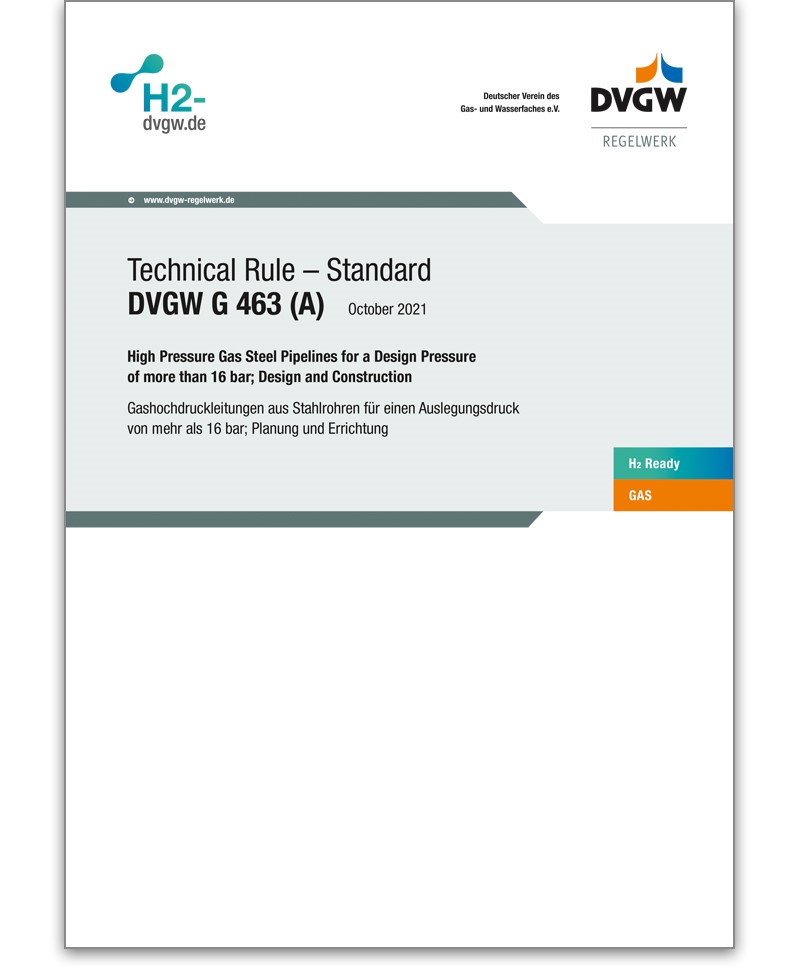G 463 Technical Rule - Standard 10/2021 -PDF file-
High Pressure Gas Steel Pipelines for a Design Pressure of more than 16 bar; Design and Construction
- Herausgeber/Verlag: DVGW
- Format: 42 pages
- Material: only as PDF available
- Ausgabe: 6th. edition 2021
- Hinweis: German version G 463
- Verkaufseinheit: 1
- Mindestabnahme: 1
- Artikel-Nr.: 512260
79,28 €*
In conjunction with DIN EN 1594, this Technical Rule G 463 applies to the planning and construction of steel high pressure gas pipelines with a design pressure of more than 16 bar for supplying gas to the general public as well as to connected energy facilities on company premises and in the field of commercial gas application of gases of the 2nd and 5th gas family as defined by DVGW Code of Practice G 260.
The scope of application has no upwards limitation in terms of the technical parameters nominal diameter and design pressure.
This Technical Rule can be applied mutatis mutandis to the construction of high pressure gas pipelines which do not conform to the specifications of DVGW Code of Practice G 260, provided that the specific characteristics of the gases or, if applicable, other already existing technical sets of rules are taken into account.
Preface
1 Scope of Application
2 Normative References
2.1 DVGW Sets of Rules
2.2 National Standards
2.3 Other Technical Rules
2.4 Acts and Ordinances
3 Terms and Definitions
3.1 General
3.2 Built-up Areas
4 Basic Requirements
4.1 General
4.2 Quality Assurance and Management Systems
4.3 Construction and Calculations Documents
4.4 Construction Supervision
4.5 Pipeline Construction Contractor
5 Design Requirements
5.1 Design
5.2 Route Selection
5.3 Soil
5.4 Depth of Cover
5.5 Right-of-Way
5.6 Distance to Buried Installations
5.7 Laying of Pipelines in Canals and Passages
5.8 High-Voltage Installations
5.9 Wind Turbines
5.10 Section Valves
5.11 Pressure Control and Overpressure Protection
5.11.1 Pressure Control
5.11.2 Overpressure Protection
5.12 Corrosion Protection
5.13 High Pressure Gas Pipelines in Areas with Increased Safety Requirement
5.14 Construction Drawings
6 Constructional Requirements for Pipeline Components
6.1 General
6.2 Pipes
6.2.1 Calculation
6.2.2 Testing
6.2.3 Proof of Quality
6.3 Factory Bends, Fittings, Expansion Joints, and Condensate Receiver
6.3.1 Calculation
6.3.2 Materials
6.3.3 Manufacturing
6.3.4 Testing
6.3.4.1 General
6.3.4.2 Factory Bend
6.3.4.3 Fittings
6.3.5 Proof of Quality
6.4 Flanged Joints
6.4.1 Calculation and Design
6.4.2 Flange Materials and Flange Testing
6.4.3 Gaskets for Flanged Joints
6.4.4 Screws and Nuts
6.5 Shut-off Valves
6.6 Isolation Joints
6.6.1 General
6.6.2 Insolating Flange Joints
6.6.3 Ready-made Isolation Joints
6.7 Manufacturing Requirements
7 Construction
7.1 Working Area
7.2 Depth of Cover
7.3 Pipe Trench
7.4 Pipe Connections
7.5 Elastic Bending
7.6 Bends
7.7 Corrosion Protection
7.8 Testing Passive Corrosion Protection
7.9 High Pressure Gas Pipeline Laying and Pipe Trench Backfilling
7.10 Pipejacking
7.11 Installation of Pipeline Components
7.12 Marking of High Pressure Gas Pipeline Route
7.13 Above-ground Pipeline Components
7.14 Technical Documentation
8 Pressure Testing of the Installed High Pressure Gas Pipeline
8.1 General
8.2 Safety Measures
8.3 Pressure Testing Methods
8.4 Non-yet backfilled Pipeline Sections
8.5 Drying
8.6 Geometry Testing
9 Preliminary Acceptance Certificate as Specified by Section 6 Clause 1 Number 1 of the Ordinance on High Pressure Gas Pipelines
10 Commissioning
11 Final Certificate as Specified by Section 6 Paragraph 2 of the Ordinance on High Pressure Gas Pipelines
Annex A (informative) – Example Construction Supervisor’s Approval Document
Annex B (informative) – Example Pipe Book
B.1 Example Pipe Book Cover Sheet
B.2 Example Pipe Tally
Annex C (normative) – Fracture Mechanics Testing
C.1 General
C.2 Fracture Mechanics Evaluation
Further Reading

